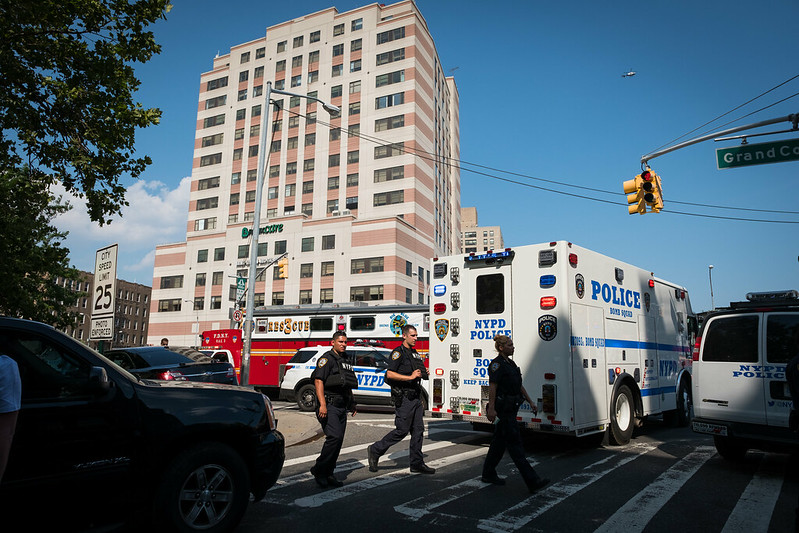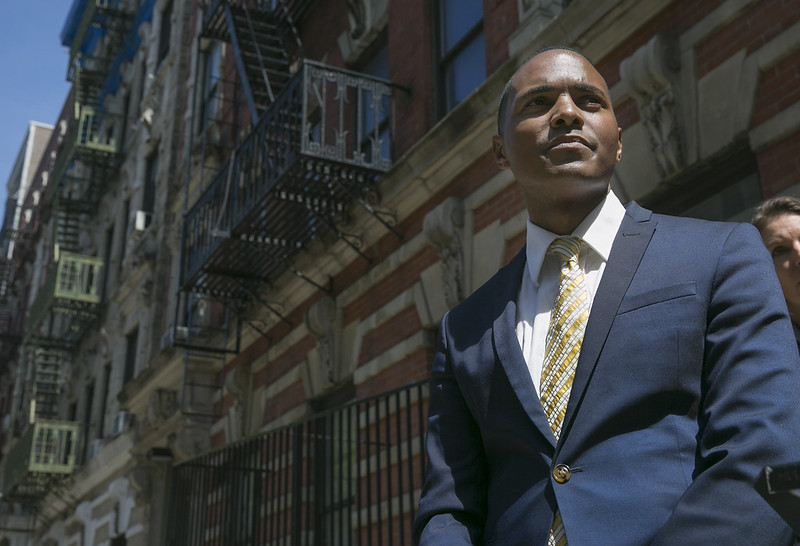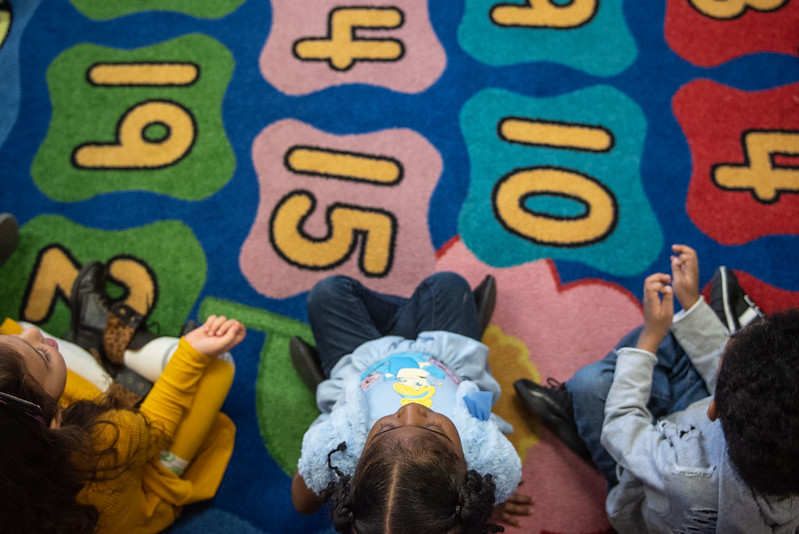Defund the NYPD and Save Black and Brown Lives by Reforming Mental Health Crisis Response

Questioning one role of the NYPD (photo: Edwin J. Torres/Mayor's Office)
The protests that have erupted across American cities in response to the murder of George Floyd, together with the larger movement for Black lives, have amplified advocates’ calls to defund the police and reallocate resources toward services that would better meet the needs of Black Americans and over-policed communities nationwide.
New York City’s police budget alone surpasses its spending on housing, hospitals, youth services, and homeless services combined. In response to public outcry, the City Council finally appears ready for a historic reckoning as it now pushes to cut $1 billion from the New York Police Department.
The coalition we help lead, Correct Crisis Intervention Today - NYC: Fighting to Transform Responses to Mental Health Crises (CCIT-NYC), has proposed one such defunding measure, which would remove mental health crisis responses from the NYPD’s portfolio entirely.
CCIT-NYC urges the City Council to redirect $16.5 million of NYPD funding to a five-year pilot project in two of the city’s most impacted precincts, Brooklyn’s 75th and Midtown South.
At the cost of $3.3 million per year, our proposed pilot would pair Emergency Medical Technicians with trained “peers” (people with lived experience of mental health crises). These teams, in place of law enforcement, would serve as first responders for people experiencing a mental health crisis.
Unlike the city’s current Health Engagement and Assessment Teams, which are only available for part of the day and cannot be dispatched directly to the general public, the teams proposed by CCIT-NYC would be available 24/7 and accessible to the public.
This is a proven model. It is similar to the hugely successful CAHOOTS program used in Eugene, Oregon, for over 30 years without any serious injuries to the health-care workers. It is easily adaptable to neighborhoods here.
Critically, this approach enjoys wide public support. A national survey conducted in early June found that nearly 70% of likely voters support “creating a new agency of first-responders, like emergency medical services or firefighters, to deal with issues related to addiction or mental illness that need to be remedied but do not need police.” A majority of those surveyed also agree that police frequently use unnecessary violence; in our city, we know this to be all too true.
Over the last five years, 14 New Yorkers experiencing a mental health crisis were killed by police responders, a 15th died by a self-inflicted gunshot during a police engagement, and another three were shot by police and left critically wounded. Just this week, one more New Yorker with mental health concerns died at the hands of NYPD after being repeatedly tasered at his home, having threatened no one.
What’s more, that number killed between 2015 and 2020 is double the number killed during the preceding years spanning 2007 to 2014. Notably, these shootings increased despite the fact that, during the same five-year period, 15,000 officers received Crisis Intervention Training to use de-escalation techniques under these very circumstances.
Having worked in the fields of mental health, human services, and criminal justice for decades, we are well aware of the racial disparities in accessing care, and of the wrongful criminalization of Black and brown individuals. As documented by the U.S. Surgeon General, people of color have less access to mental health services than white people, are less likely to receive needed care, and are more likely to receive poor-quality care when they are treated. Of the 18 individuals shot in police encounters in New York City, 16 were Black or other persons of color.
Of particular note during these precarious financial times is the fact that instituting mental health response teams would pay for itself in savings. Each year, New York City spends approximately $250 million on cases involving police misconduct by the NYPD, and we estimate that roughly one-third of those cases involve people undergoing a mental health crisis.
The time is right to pilot a culturally competent and compassionate, peer-driven model for responding to mental health crises that avoids inflicting further harm by eliminating the unnecessary use of police, emergency rooms, and psychiatric hospitals. Our proposed pilot’s use of non-police responders trained in engagement and de-escalation techniques would spare the city expensive lawsuits and save lives – particularly those of Black and brown New Yorkers.
Let’s restore faith that when people call for help in times of crisis, they receive actual help and health care, not the law enforcement response they have come to fear.
***
by Cal Hedigan of Community Access; Jim Mutton of Concern for Independent Living, Inc.; Matt Kudish of National Alliance on Mental Health Illness NYC; and Ruth Lowenkron, Esq., of New York Lawyers for the Public Interest.
***
Have an op-ed idea or submission for Gotham Gazette? Email This email address is being protected from spambots. You need JavaScript enabled to view it.
2020 Primaries: Winds of Change Shifting Latino Politics in New York City

Ritchie Torres (photo: William Alatriste/City Council)
As this month’s primary election results seem to be proving, the winds of change are blowing and are shifting the direction of Latino politics in New York City. Has a new era of leadership in Latino political representation arrived?
In the Bronx, Ritchie Torres seems to be ahead with a comfortable margin, defeating Michael Blake, long-time politico Ruben Diaz, Sr., and many others in the 15th Congressional District. In these pages I predicted that Torres was one to take very seriously. The future has arrived. When all ballots are counted, I expect Torres to pull off the victory.
Torres now joins Alexandria Ocasio-Cortez (AOC), Nydia Velazquez, and Adriano Espaillat as the Latino congressional representatives in New York City. Torres and AOC, though, represent a new and perhaps more progressive voice, one that is representative of the younger Latino generation. Surveys indicate that members of this younger generation tend to be more progressive than their parents and grandparents. Three years ago (when AOC was still bartending) I wrote: “Torres is charismatic, well-liked by his peers, and whip-smart. He has the uncanny ability to probe and articulate complex policy matters. At 29 years of age, Torres will surely be one to watch for years to come.”
Now with a bigger platform, I anticipate that Torres will be a formidable force on behalf of the Latino community for years to come.
Perhaps the strongest wind of change in Latino politics is blowing from Queens. Jessica González-Rojas appears to be defeating incumbent Assemblymember Michael DenDekker. González-Rojas, who was endorsed by Tiffany Cabán but interestingly enough not AOC, is now the fourth Latina to be elected in Queens, following the elections of AOC, Jessica Ramos, and Catalina Cruz two years ago.
Two things are important about these successes: First, that we are seeing the rise of female representation among Latino political representatives. Latinas have rightly felt emboldened by the lack of progress that was evident in our communities and have responded by elbowing their way to the table, knowing that they have something to offer and contribute to Latino communities. And the communities are responding by electing them.
Currently, there are 31 Latino elected officials in the city, including the addition of González-Rojas. Women now represent 42% of all Latino elected officials in the city—from Congress to the City Council. (Here, I am not including the numerous women that hold party positions.) While there is much more to do to make that figure more representative of the Latina presence within the electorate and society at large, the trend is encouraging.
With the re-election of the women mentioned above, and the election of González-Rojas, the 2020 primary election cycle may come to be known as the year of the Latina. It’s about time! I am certain that the late Olga Mendez, the first Latina in the country to be elected to the state Legislature (representing East Harlem for many years) is smiling from above.
Additionally, the addition of González-Rojas to Queens’ representation also marks a shift in the center of Latino voter participation and presence. Whereas formerly the Bronx was almost exclusively where Latino elected officials resided, we are now seeing the results of what has been a steady increase in the Latino population in Queens. As we’ve seen with AOC, Ramos, Cruz, and now González-Rojas, more Latino candidates are being elected in the borough of Queens. The Archie Bunker days seem to be over. A new era is being ushered in.
In the future, I will take a deeper dive into the significance of the Latino vote in this primary cycle. For now, as results continue to trickle in and as we await the Board of Elections’ counting of absentee ballots and certification of outcomes, the Latino community should be proud of its seeming awakening.
***
Eli Valentin is a political analyst and author of the forthcoming book, Reinhold Niebuhr: A Political Life. On Twitter @EliValentinNY.
***
Have an op-ed idea or submission for Gotham Gazette? Email This email address is being protected from spambots. You need JavaScript enabled to view it.
Reimagine Education in New York – Without Segregation

(photo: Michael Appleton/Mayoral Photography Office)
Governor Andrew Cuomo has called rightly on New Yorkers, in the face of the COVID-19 pandemic, to reimagine education. We should reimagine it without racial segregation.
The novel coronavirus’ path of destruction has starkly illuminated the structural racism that underpins so much inequality in America. That inequality includes educational segregation in New York.
Structural racism, which is the historical and ongoing racial discrimination and segregation of Black people in particular, is typically instigated or sanctioned by government. It has created the unequal foundation for so many aspects of life, including widely documented, underlying health disparities for Black and Latino individuals. It has played a fundamental role in where we live (through federal redlining and other discriminatory practices) and, therefore, where our children attend school.
As a result of structural racism, New York is the most segregated state for African-American students, with 65 percent of African-American students in intensely segregated schools. That designation is heavily influenced by the New York City public school system, but the segregation is statewide. That segregation is often formally structured through the fragmentation of school districts.
Long Island’s two counties, for instance, have 125 school districts. Not surprisingly, Long Island is one of the 10 most segregated metro regions in the nation, and segregation is on the rise. According to ERASE Racism, in 2017, dramatically more Black and Latino students on Long Island attended segregated schools than 12 years earlier. New York City is also among the 10 most segregated metro regions, and its public schools are similarly highly segregated.
Yet distance learning, now a sudden reality, may have a valuable role to play in undermining segregation. It offers a vehicle for creating digital course offerings and other convenings that could free students from the entrenched landscape of racial isolation and inequity.
Through distance learning, students from multiple school districts could come together to learn and share experiences without being constrained by the geographic limitations imposed on them by previous generations and their prejudices. They might come together, for instance, for Advanced Placement courses or International Baccalaureate classes and broaden their understandings by sharing insights with students from other backgrounds.
They might also convene digitally for extracurricular activities. A model for that already exists with ERASE Racism’s Student Task Force, which consists of 23 high school students from 17 schools in Nassau and Suffolk counties on Long Island. While the Task Force previously met in person for most of its activities, we began meeting exclusively remotely in response to the pandemic. The Task Force and its thoughtful discussions, plans, and programs demonstrate the extraordinary benefits of students convening across school districts and even counties to learn together and from each other.
Implementing distance learning across school districts at a significant scale would require a more aggressive role by the State Education Department. The implementation of initial distance-learning initiatives amid the pandemic – with each school district acting in isolation, regardless of existing resources and capacity – merely reinforced the educational disparities already in place, as wealthier, whiter school districts were inevitably better able to implement those initiatives than poorer districts with more Black and Latino students.
Regardless of whether the decision to leave districts on their own was made deliberately or by default in the face of the looming pandemic, now is the time to prepare for enhanced educational outcomes in the new school year. Now is the time to think more creatively about options. That is where the opportunity for innovation emerges – both in how education can be advanced through distance learning, which is presumably here to stay to a degree still to be determined, and in diversifying educational instruction and environments in the process.
Three steps are key: First, the state should provide the needed funding to ensure that poor school districts can take advantage of online instruction, with enhanced tools and training to enable all teachers to deliver optimum instruction on distance-learning platforms. Second, the state should work with Internet providers to ensure that students in poor communities have Internet access affordably – even free. Third, the Board of Regents should ensure that every child has access to the equipment, connectivity, and instruction needed for effective utilization of distance learning.
In that context, New York should ensure that curricula are culturally responsive, reflecting the diversity of race, ethnicities, and cultures represented in our country and in New York state, even though they are not represented in all districts. Fortunately, the State Education Department has already developed a “Culturally Responsive-Sustaining Education Framework,” on which ERASE Racism provided feedback as it evolved.
The Framework helps educators create student-centered learning environments that affirm diverse identities, while preparing students for rigor and independent learning and elevating historically marginalized voices, among other goals. It addresses the reality that, in order to tackle racial disparities across the nation, it is necessary to have conversations in classrooms about the truth of structural racism throughout history and in the present day.
In reimagining education in New York, those same historically marginalized voices are stakeholders that need to be engaged: students, educators, parents, and community members. Those whose work and passion have focused on identifying and addressing the structural racism that has kept segregation in place must be fully involved, as their insights are vital to dismantling that persistent scourge. ERASE Racism stands ready to help in that endeavor.
Governor Cuomo has called on New Yorkers to reimagine education in the face of COVID-19. Now is the time to convert this public health and economic tragedy into a catalyst to destroy the perpetual plague of racial segregation and inequity.
***
Elaine Gross is president of the regional civil rights organization ERASE Racism. On Twitter @EraseRacism.
***
Have an op-ed idea or submission for Gotham Gazette? Email This email address is being protected from spambots. You need JavaScript enabled to view it.




